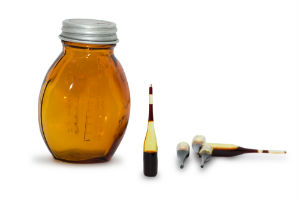
You’ve probably heard of iodine before, but what is iodine and what is it used for? You may remember from Chemistry class, Iodine is a chemical element of the periodic table with the symbol I and atomic number 53. But Besides knowing the physical properties of iodine, you may not be aware of exactly what iodine is and the immense history behind the use of this vital element. From the various types of iodine to the amount required for optimum health, there is a lot to know about this water-soluble trace element.
http://youtu.be/oDRd40VK5PY
Iodine is Required for Health
We need many substances for health, and none do more for us than iodine. Traditionally sourced from the sea, iodine is required by the body for a number of functions. First and foremost, your thyroid gland utilizes iodine to make thyroid hormones. A lack of iodine can cause the thyroid gland to swell up (known as goiter) in an attempt to increase the uptake of iodine from the blood.
Iodine is also instrumental in brain development, with an inadequate amount actually leading to the most avoidable form of mental retardation known as iodine deficiency-related retardation. Infants, in fact, may actually face lethal consequences if their mothers are severely deficient in iodine. Spiking miscarriage and stillbirth rates, and iodine deficiency can have major repercussions. A research conducted at Arizona State University even linked iodine deficient mothers to autistic offspring.
Iodine can do even more for us! It’s a terrific cleanser, can prevent harm from radiation, and is a detoxing agent. Yet, it’s next to ignored by most modern doctors. This wasn’t always the case, let’s take a look at the history behind iodine.
History of Iodine – The 20s and Now
It wasn’t until 1924 that iodine was added to salt in order to address the widespread number of iodine deficiencies sweeping the nation during that time. Specifically, Great Lakes and Pacific Northwest region were experiencing outbreaks of goiter – the swelling of the thyroid that is entirely avoidable through the utilization of proper iodine levels. The reason? Soil levels were drastically lacking in iodine, and the general public was avoiding foods rich in iodine such as kale, cranberries, and strawberries.
But it’s not the 1920s anymore. These days, processed chemicals have become the norm due to price cutting measures and an ideology of better living through synthetic chemistry. Salt that was previously harvested and sold with minimal processing now exists only as natural, sea salt sold in health food stories. Today, table salt is actually a manufactured form of sodium that is known as sodium chloride.
Sodium chloride does contain added iodine, but also comes with a host of chemical additives and a loss of nutritional value. After being bleached, processed, and loaded with substances like fluoride sodium bicarbonate, modern day table salt is more of a health hazard than an iodine-containing health substance. Skip it.
Iodine Facts
Even though every aspect of our lives requires iodine. It’s a natural element that’s required to regulate metabolism. White table salt is supplemented with iodine, but it’s unhealthy. Iodine deficiency is tied to many serious health problems.
Lack of iodine has been tied to breast cancer. So-called iodine “allergies” have nothing to do with iodine! This is just the beginning of the fascinating information about iodine’s value and uses.
Forms of Iodine
Iodine occurs naturally in two primary forms, elemental and ionic. Elemental iodine refers to the atom itself, which is found primarily in the ocean. Single iodine atoms don’t float around by themselves in nature. Atomic iodine refers to two iodine atoms bonded together. In this form, it’s usually highly corrosive. Read more
No comments:
Post a Comment